

All-Women Self-Defense Militia In Guerrero, Mexico Says They Are Capable Of Defending Their Town Against Drug War Violence. More than 100 women from the town of Xaltianguis, about 30 miles from the resort of Acapulco in Mexico's southern state of Guerrero, have taken up arms against organized crime in their town forming all-women regiments in a local community self-defense group known as the Union of Organized Peoples of the State of Guerrero (UPOEG).
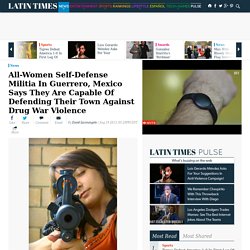
On Sunday, the women put on their new citizen-police uniforms and gathered in their town's plaza, where they took an oath to defend their community. Miguel Ángel Jiménez Blanco, the commander of the community police in Xaltianguis, told Animal Politico that the women have undergone training on how to handle the 80 or so firearms which the self-defense patrols rotate among themselves. Jiménez Blanco said that the women had made the decision to join the UPOEG within the last four days.
"We have an average of nine groups" of community police, he said, each one made up of 12 women who will go on patrol during the day in Xaltianguis. Intentional community. Characteristics[edit] Purpose[edit] The purposes of intentional communities vary in different communities.

They may include sharing resources, creating family-oriented neighborhoods and living ecologically sustainable lifestyles (ecovillages). Local food. Local food or the local food movement is a "collaborative effort to build more locally based, self-reliant food economies - one in which sustainable food production, processing, distribution, and consumption is integrated to enhance the economic, environmental and social health of a particular place.

"[1] It is not solely a geographical concept. A United States Department of Agriculture publication explains local food as "related to the distance between food producers and consumers," as well as "defined in terms of social and supply chain characteristics. Local food systems[edit] Local food system diagram. Agroecology. Agroecology is the study of ecological processes that operate in agricultural production systems.

The prefix agro- refers to agriculture. Bringing ecological principles to bear in agroecosystems can suggest novel management approaches that would not otherwise be considered. Permaculture. With its system of applied education, research and citizen- led design permaculture has grown a popular web of global networks and developed into a global social movement[citation needed].
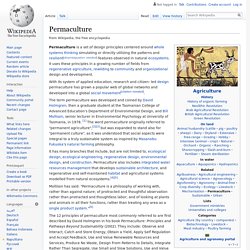
The term permaculture was developed and coined by David Holmgren, then a graduate student at the Tasmanian College of Advanced Education's Department of Environmental Design, and Bill Mollison, senior lecturer in Environmental Psychology at University of Tasmania, in 1978. [1] The word permaculture originally referred to "permanent agriculture",[3] but was expanded to stand also for "permanent culture", as it was understood that social aspects were integral to a truly sustainable system as inspired by Masanobu Fukuoka’s natural farming philosophy. It has many branches that include, but are not limited to, ecological design, ecological engineering, regenerative design, environmental design, and construction.
History[edit] Several individuals revolutionized the branch of permaculture. In Australian P.A. Bioregionalism. Bioregionalism is a political, cultural, and ecological system or set of views based on naturally defined areas called bioregions, similar to ecoregions. Bioregions are defined through physical and environmental features, including watershed boundaries and soil and terrain characteristics.
Bioregionalism stresses that the determination of a bioregion is also a cultural phenomenon, and emphasizes local populations, knowledge, and solutions.[1] Overview[edit] The bioregionalist perspective opposes a homogeneous economy and consumer culture with its lack of stewardship towards the environment. This perspective seeks to: Cogeneration. Trigeneration cycle Cogeneration or combined heat and power (CHP) is the use of a heat engine[1] or power station to simultaneously generate electricity and useful heat.

Trigeneration or combined cooling, heat and power (CCHP) refers to the simultaneous generation of electricity and useful heating and cooling from the combustion of a fuel or a solar heat collector. A plant producing electricity, heat and cold is called a trigeneration[2] or polygeneration plant. Cogeneration is a thermodynamically efficient use of fuel. In separate production of electricity, some energy must be discarded as waste heat, but in cogeneration this thermal energy is put to use. The supply of high-temperature heat first drives a gas or steam turbine-powered generator and the resulting low-temperature waste heat is then used for water or space heating as described in cogeneration.
Resource management. In organizational studies, resource management is the efficient and effective development of an organization's resources when they are needed.
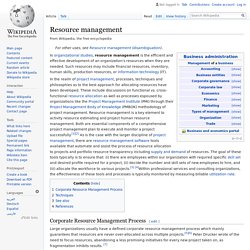
Such resources may include financial resources, inventory, human skills, production resources, or information technology (IT). In the realm of project management, processes, techniques and philosophies as to the best approach for allocating resources have been developed. These include discussions on functional vs. cross-functional resource allocation as well as processes espoused by organizations like the Project Management Institute (PMI) through their Project Management Body of Knowledge (PMBOK) methodology of project management. Resource management is a key element to activity resource estimating and project human resource management.
Corporate Resource Management Process[edit] Asset-based community development. Asset-based community development (ABCD) is a methodology that seeks to uncover and use the strengths within communities as a means for sustainable development.

The first step in the process of community development is to assess the resources of a community through a capacity inventory [1] or through another process of talking to the residents to determine what types of skills and experience are available. The next step is to support communities, to discover what they care enough about to act. The final step is to determine how citizens can act together to achieve those goals.[1] Asset management. Infrastructure asset management[edit] Infrastructure asset management is the combination of management, financial, economic, engineering, and other practices applied to physical assets with the objective of providing the required level of service in the most cost-effective manner.
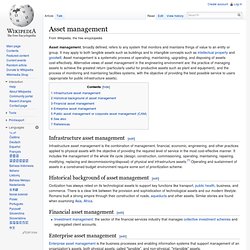
It includes the management of the whole life cycle (design, construction, commissioning, operating, maintaining, repairing, modifying, replacing and decommissioning/disposal) of physical and infrastructure assets.[1] Operating and sustainment of assets in a constrained budget environment require some sort of prioritization scheme. Historical background of asset management[edit] Civilization has always relied on its technological assets to support key functions like transport, public health, business, and commerce. Self-sufficiency. Self-sufficiency (also called self-containment) is the state of not requiring any aid, support, or interaction, for survival; it is therefore a type of personal or collective autonomy.
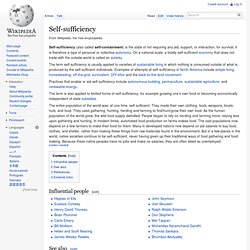
On a national scale, a totally self-sufficient economy that does not trade with the outside world is called an autarky. Self-sustainability. A system is self-sustaining (or self-sufficient) if it can maintain itself by independent effort. The system self-sustainability is: the degree at which the system can sustain itself without external supportthe fraction of time in which the system is self-sustaining. Resilience (organizational) "Resilience" is defined as “An organization’s capacity to anticipate disruptions, adapt to events, and create lasting value.
" The concept of resilience is rapidly advancing as a practical response to the needs of an organization, enterprise or government to effectively address the combined issues of security, preparedness, risk, and survivability. Resilience is an organization’s capacity to maintain its functions and structure in the face of internal or external change or threat. To further clarify the definition, one can look to the conditions that speak to resilience as within the following set of statements: It is logical to expect that an organization that realizes the benefits of the above definition of resilience will have a high likelihood of maintaining a successful and thriving enterprise.
Disruption seems to be everywhere these days – industries collapsing, storm surges shutting down major urban centers, financial markets imploding, and more. Global turbulence is expected. Autonomy. Sociology[edit] In the subfield of sociology called the sociology of knowledge, controversy over the boundaries of autonomy stopped at the concept of relative autonomy,[1] until a typology of autonomy was created and developed within science and technology studies.
According to it, the contemporary form of science's existing autonomy is the reflexive autonomy: actors and structures within the scientific field are able to translate or to reflect diverse themes presented by social and political fields, as well as influence them regarding the thematic choices on research projects. Empowerment. Empowerment refers to increasing the economic, political, social, educational, gender, or spiritual strength of individuals and communities. Definitions[edit] The term covers a vast landscape of meanings, interpretations, definitions and disciplines ranging from psychology and philosophy to the highly commercialized self-help industry and motivational sciences. "Marginalized" refers to the overt or covert trends within societies whereby those perceived as lacking desirable traits or deviating from the group norms tend to be excluded by wider society and ostracized as undesirables.
Sometimes groups are marginalized by society at large, but governments are often unwitting or enthusiastic participants. This Act made it illegal to restrict access to schools and public places based on race.